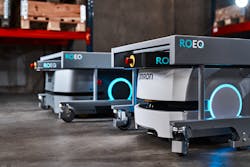The manufacturing industry’s use of autonomous mobile robots (AMRs) may lag behind its adoption of cartesian, SCARA, delta and six-axis robots, but AMR use is growing fast driven by industry’s ongoing labor issues and the cost/benefit factor of automating materials transport as robot costs have dropped.
To help simplify wider deployment of AMRs across industry, RoEq has developed lifter, roller and cart AMR systems that the company says are ready to use off the shelf. RoEq says these systems can handle and transport everything from light parts and boxes to heavy goods like European or U.S. pallets in production or warehouse facilities. Enabling RoEq to deliver these systems that are ready to use is the fact that RoEq does not develop the AMRs. Instead if focuses on the assemblies that connect to AMRs to manage the materials transport. Current RoEq AMR partners are MiR, Omron and Continental.
A key enabler to the off-the-shelf usability of RoEq’s AMR technology is its RoEq Assist software, which is developed following a consultation with RoEq. This consultation process allows RoEq to deliver the software with the coding and much of the setup for the AMR system already installed. In addition, RoEq Safety addresses compliance with relevant safety standards.
While the cart and lifter AMR systems offered by RoEq will be familiar to those who have seen AMRs in operation before, the roller systems are a more recent addition to AMRs that are driving increased use of the technology. These roller systems are used to transfer loads between conveyors using AMRs. RoEq’s GuardCom system secures the connection between the AMR and the conveyor to enable reliable transfer of materials from the AMR to the conveyor for use in assembly, processing or packaging. Auto top rollers are available for transferring between stations of different heights.
In the video below, Carsten Sørensen of RoEq explains the company’s off-the-shelf systems for AMRs, showcasing the latest integration with Omron’s LD-90 AMR.

